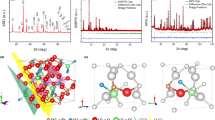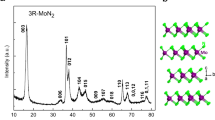Abstract
THE unstable blue compounds obtained by the reduction of tungstic oxide with active hydrogen were classified as “bronzes” by Glemser1,2 and shown by X-ray powder photography to exhibit structural variations with composition similar to those observed for the alkali-metal tungsten bronzes. In this note we report a new tetragonal hydrogen bronze phase with the same crystal structure as Na(0.1)WO3 (ref. 3), and with 0.21<x<0.25.
This is a preview of subscription content, access via your institution
Access options
Subscribe to this journal
Receive 51 print issues and online access
$199.00 per year
only $3.90 per issue
Buy this article
- Purchase on Springer Link
- Instant access to full article PDF
Prices may be subject to local taxes which are calculated during checkout
Similar content being viewed by others
References
Glemser, O., and Naumann, C., Z. Anorg. Chem., 265, 289 (1951).
Glemser, O., and Lutz, G., Z. Anorg. Chem., 263, 17 (1951).
Magneli, A., Acta Chem. Scand., 5, 670 (1951).
Author information
Authors and Affiliations
Rights and permissions
About this article
Cite this article
DICKENS, P., HURDITCH, R. X-ray and Neutron Diffraction Studies of a Tetragonal Hydrogen Bronze HxWO3. Nature 215, 1266–1267 (1967). https://doi.org/10.1038/2151266a0
Received:
Issue Date:
DOI: https://doi.org/10.1038/2151266a0
This article is cited by
-
Titania supported synergistic palladium single atoms and nanoparticles for room temperature ketone and aldehydes hydrogenation
Nature Communications (2020)
-
Effect of hydrogen doping on the loading of titania nanotube films with copper selenide species via alternating current deposition
Journal of Applied Electrochemistry (2015)
-
Color centres and polymorphism in pure WO3 and mixed (1−x)WO3−y·xReO2 powders
Ionics (1999)
-
Reversible isothermal sorption of hydrogen by tungsten trioxide in presence of platinum
Nature (1983)
-
Hydrogen insertion compounds of transition metal oxides
Journal of Electronic Materials (1981)
Comments
By submitting a comment you agree to abide by our Terms and Community Guidelines. If you find something abusive or that does not comply with our terms or guidelines please flag it as inappropriate.



